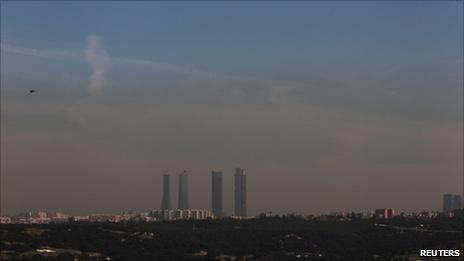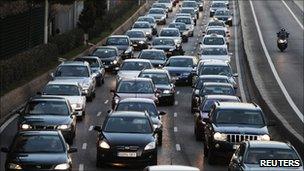Madrid in smog warning to commuters
- Published

Madrid's air pollution problem has been exacerbated by an unusual weather pattern
Madrid's city council is calling on commuters to take public transport and combat a spike in air pollution levels.
The council has put up signs on motorway display panels advising drivers of high contamination.
The warnings began after nitrogen dioxide (NO2) was recorded at least five times above the limit set by the EU as the safe annual average.
The council is already under scrutiny for failing to tackle air pollution, and apparently distorting data.
'Black cap'
Levels of NO2 in Madrid - mainly the result of car exhausts - are consistently over the EU hourly limit of 200 micrograms per cubic metre.
But the situation this month has been exacerbated by an unusual weather pattern.

Forecasters say air pollution levels will continue until the end of this week
An anticyclone - an area of high atmospheric pressure - is preventing the air pollution dispersing as it normally would, leaving it hanging over Madrid and forming what Spaniards are calling a "black cap of contamination".
The neon warning signs first appeared above Madrid's ring road on Monday evening, although the council insists the NO2 levels are not dangerous and that it is merely taking precautions.
Released when fossil fuels such as petrol are burned, NO2 contributes to the formation of fine particle pollution and acid rain - as well as the depletion of the ozone layer. It also has a detrimental effect on the respiratory system.
But environmentalists are angry at the city council's response, saying the air pollution problem is a constant one that requires long-term solutions.
It is now five years since Madrid's mayor promised to keep cars that were heavy polluters out of the city centre. In 2008, he announced the measure had been postponed. It still has not happened.
"Usually, nature disperses the pollution and we don't feel the effects like this," says Paco Segura of Ecologists in Action. "But when nature fails us, like now, we get the full impact."
The group - which has lodged a legal complaint against the council - says the average annual level of NO2 in Madrid fell slightly in 2010 to 44 micrograms per cubic metre.
That is still above the EU limit of 40 micrograms per cubic metre. And activists suggest the figures have been distorted deliberately by the council.
In 2009, the council moved numerous air pollution sensors from areas of heavy traffic and contamination in the city centre - including near Atocha station and beside the busy boulevard of Paseo de Recoletos.
"One of the sensors is right at the city limits now, where the pollution is very low," explains Mr Segura. "Other sensors were moved from busy places and put in parks."
The mayor says he was complying with EU instructions to spread out the sensors.
Problems 'unresolved'
The Spanish state prosecutor responsible for the environment is currently investigating.

Most commuters are ignoring the appeals to take the train into the centre of Madrid
Last May, he informed the council that it needed to bring air pollution levels to within legal norms, describing the air in Madrid as "notably contaminated".
The prosecutor also stressed that moving sensors from contaminated areas gave "the impression that Madrid is suddenly a lot less polluted".
However, he added that "the real problem of pollution levels in the city centre remains unresolved".
With no sign of rain, forecasters say the current, particularly high air pollution levels in Madrid will continue until the end of this week at least.
But so far, most commuters are ignoring the appeals to take the train. Transport officials say traffic on the M30 motorway is just as heavy as usual.
- Published27 January 2011